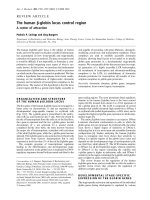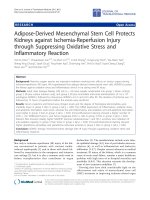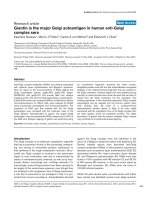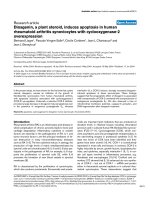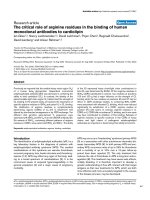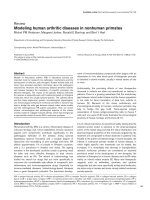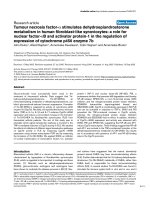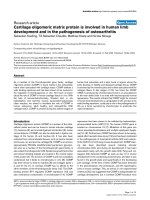Báo cáo y học: " Defining human mesenchymal stem cell efficacy in vivo" ppsx
Bạn đang xem bản rút gọn của tài liệu. Xem và tải ngay bản đầy đủ của tài liệu tại đây (1.21 MB, 12 trang )
Bonfield et al. Journal of Inflammation 2010, 7:51
/>
RESEARCH
Open Access
Defining human mesenchymal stem cell
efficacy in vivo
Tracey L Bonfield1*, Mary T Nolan (Koloze)1, Donald P Lennon2, Arnold I Caplan2
Abstract
Allogeneic human mesenchymal stem cells (hMSCs) can suppress graft versus host disease (GvHD) and have
profound anti-inflammatory and regenerative capacity in stroke, infarct, spinal cord injury, meniscus regeneration,
tendinitis, acute renal failure, and heart disease in human and animal models of disease. There is significant clinical
hMSC variability in efficacy and the ultimate response in vivo. The challenge in hMSC based therapy is defining the
efficacy of hMSC in vivo. Models which may provide insight into hMSC bioactivity in vivo would provide a means
to distinguish hMSCs for clinical utility. hMSC function has been described as both regenerative and trophic
through the production of bioactive factors. The regenerative component involves the multi-potentiality of hMSC
progenitor differentiation. The secreted factors generated by the hMSCs are milieu and injury specific providing
unique niches for responses in vivo. These bioactive factors are anti-scarring, angiogenic, anti-apoptotic as well as
regenerative. Further, from an immunological standpoint, hMSC’s can avoid host immune response, providing
xenographic applications. To study the in vivo immuno-regulatory effectiveness of hMSCs, we used the ovalbumin
challenge model of acute asthma. This is a quick 3 week in vivo pulmonary inflammation model with readily accessible ways of measuring effectiveness of hMSCs. Our data show that there is a direct correlation between the traditional ceramic cube score to hMSCs attenuation of cellular recruitment due to ovalbumin challenge. The results
from these studies verify the in vivo immuno-modulator effectiveness of hMSCs and support the potential use of
the ovalbumin model as an in vivo model of hMSC potency and efficacy. Our data also support future directions
toward exploring hMSCs as an alternative therapeutic for the treatment of airway inflammation associated with
asthma.
Introduction
Human mesenchymal stem cells (hMSCs) from marrow
reside in situ as pericytes that are hypothesized to function as sentinels to guard against self-surveillance by
T-cells at sites of tissue damage [1]. The local titers of
hMSCs depend on the vascular density at that site and
on other factors. Although hMSCs were first thought to
function as the source for cellular replacement therapies,
their immuno-modulatory and trophic activities have the
potential for profound therapeutic impact in diseases
associated with sustained inflammation. By providing
additional hMSCs through systemic routes, both
immuno-regulatory and regenerative trophic activities
at sites of inflammation and tissue damage can be
enhanced [2].
* Correspondence:
1
Department of Pediatrics, Case Western Reserve University, Cleveland, OH.
USA
Full list of author information is available at the end of the article
hMSCs are non-hematopoietic, multi-potent progenitor cells, which have the ability to influence immune
effector cell development, maturation and function as
well as allo-reactive T-cell responses through the production of bioactive cytokines and proteins [3]. The designation of hMSCs is based upon extensive
immunophenotyping using surface antigens and ability
to function in in vitro models [4]. MSCs are immunomodulatory and express no MHC class II, making
hMSCs a viable therapeutic across tissue typing [5,6].
hMSCs produce large quantities of bioactive factors
which provide molecular signatures for the pathway and
activity status of the responding cells [7,8]. These bioactive factors are anti-scarring, angiogenic, anti-apoptotic
and regenerative (i.e., mitotic for host-derived progenitor
cells). As evidence of the profound effect of hMSCs on
the immune system, our colleagues and others have
reported that hMSCs are well tolerated and therapeutically active in immuno-competent rodent models of
© 2010 Bonfield et al; licensee BioMed Central Ltd. This is an Open Access article distributed under the terms of the Creative Commons
Attribution License ( which permits unrestricted use, distribution, and reproduction in
any medium, provided the original work is properly cited.
Bonfield et al. Journal of Inflammation 2010, 7:51
/>
multiple sclerosis and stroke [9-11]. Thus, xenogenic
hMSCs repress host immunological surveillance in
rodents while at the same time producing reparative
growth factors.
An important issue in hMSC biology has been understanding the significant variability among cell preparations. Models need to be developed which not only
show the relative unique therapeutic application of
hMSCs, but also measure in vivo function (i.e., therapeutic potency). Acute (short-term) in vivo models of
inflammation have the potential to provide vehicles for
hMSC efficacy assessment. Although chronic (longterms) models provide valid options for study, our focus
was on an in vivo model which would provide a quick
answer of hMSC activity, with the clinical and therapeutic applications in mind. Culture-expanded hMSCs
increase in size with each passage and thus, on a size
basis alone are observed to lodge in the lungs in substantial numbers when given intravenously [12]. hMSCs
have the potential to provide a local source of trophic
factors in the pulmonary environment, which may result
in changes in lung inflammation [13]. This circumstance
allows us to determine the effects of hMSCs in the
initiation of inflammatory lung diseases and to establish
the criteria for efficacy of different donor hMSCs on
early stages of asthma in rodent models.
Acute bronchial asthma has been characterized by
allergic airway inflammation, which induces both cytological as well as histological changes in the airway structure over time [14]. The pathogenic characteristics of
allergic asthma are associated with airway inflammation
and infiltration of mast cells, basophils, eosinophils,
monocytes and T helper type 2 lymphocytes, along with
the production of isotype-specific immunoglobulin E
(IgE) [15,16]. Several animal models have been developed
to model human airway disease associated with acute
asthma, which have the capacity to mimic the histological
and pathologic changes in the lung. A commonly used
model to study airway inflammation in vivo involves primary sensitization with ovalbumin (OVA) followed by
daily intranasal challenge with the antigen to generate
airway inflammation mimicking the acute asthma exacerbation. This short-term model can provide the basis for
studying the trophic impact of lodged hMSCs on development of lung inflammation associated with acute
asthma challenge and the potential benefit of hMSCs in
circumventing acute asthmatic inflammatory disease.
The results of these studies provide the foundation for
understanding the role of hMSCs in altering inflammatory processes in vivo and provide support for the utilization of the short-term acute asthma model as a
validation tool for hMSC efficacy and function in vivo.
Page 2 of 12
Materials and methods
Mouse Model
Balb/c mice were purchased from the Jackson Laboratories (Bar Harbor, Maine) at 5 weeks, allowed to
adjust to environment for 1 week. On day 0 (6 weeks
of age) mice were sensitized by intra-peritoneal injections (100 μL) of 10 μg of ovalbumin (OVA) emulsified
in 1.5 mg of Al (OH)3. On day 14, mice were exposed
to 1% wt/vol OVA [17,18] in sterile saline by aerosolization every day for 5 days. Sham sensitization and
sham challenges were carried out with sterile saline.
hMSCs were given on either day 14 or day 16 by tail
vein injection with 1 × 106 hMSC/mouse in 100 ul of
PBS. For each of a minimum of 3 experiments, 4-6
animals were evaluated for the following: saline challenge, saline challenge +hMSC, ovalbumin challenge,
ovalbumin challenge+hMSCs. In addition, subsets of
saline and ovalbumin mice were given bone marrow
derived macrophages (BMDM) as a control for the
hMSC. As a positive control for immunosuppression, a
subset of the ovalbumin sensitized, ovalbumin challenged mice received dexamethasone at 10 mg/kg. In
all cases, the dexamethasone significantly decreased
total cell recruitment and eosinophil counts (data not
shown) supporting our ability to measure changes in
airway inflammation.
Lung Inflammation
Mice were injected subcutaneously with ketamine (80
mg/kg) and xylazine (10 mg/kg). The thoracic cavity
was opened and lungs exposed. Bronchoalveolar lavage
(BAL) was performed by inserting a cannula through a
cut in the trachea into the bronchi and infusing 3 × 1
ml aliquots of warm PBS containing 0.2% lidocaine. The
BAL fluid sample was recovered by aspirating the liquid
with a syringe. Cells were separated from lavage fluid
and differential analysis was evaluated using cytospins
and Wright-Giemsa staining. Remaining cells were frozen for future analysis. BAL fluid was frozen at -80°C
until assessment for cytokines.
Lung Pathology
Lungs were either perfused with 10% formalin or snap
frozen. Mean viability of lavage cells was > 95% by trypan blue dye exclusion. Animals were assessed for
inflammation by BAL and a separate set of animals was
evaluated for lung histology using H&E and trichrome
staining.
Systemic Inflammation
Animals underwent cardiac puncture after completion
of lavage and the blood was processed to obtain serum
and plasma. Serum cytokines were measured using ELISAs or Luminex technology.
Bonfield et al. Journal of Inflammation 2010, 7:51
/>
MSCs
Cells were isolated from the marrow of healthy volunteers as described elsewhere [19]. Briefly, the marrow
aspirates were layered on density gradients, and the light
cell fraction was retrieved, washed and plated in selected
batches of 10% fetal bovine serum (FBS) in Dulbecco’s
Modified Eagle Medium (DMEM) [20]. Within 14 days
the colony-forming units were selectively expanded to
near confluency and the cells were then lifted from the
dish with trypsin and replated at 4500 cells/cm 2 to
ensure they maintained active cell division. As determined by other studies, cells cultured using this protocol were homogenous when FAC-Sorted using over 100
different cell surface antibodies [4]. All 7 hMSCs preparations were harvested from culture at passage 2, during log-growth and given intravenously. Just before cells
are trypsinized, they are rinsed with Tyrode’s salt solution then labeled with the vital dye, Dil at a concentration of 1 ug/ml in Tyrode’s for 20 minutes at 37°C. Dil
was initially diluted to 1 mg/ml in DMSO followed by
1:1000 diluted in Tyrode incubated for 20 minutes at
37°C. Each experimental run used hMSCs from a different donor; 7 different hMSC preparations were used for
these studies.
Bone marrow derived macrophages (BMDM)
BMDM were utilized in a subset of studies (n = 3).
Briefly, bone marrow aspirates were obtained from syngeneic mice and cultured in the presence of L929 media
as previously defined [21].
Ceramic Cube Assay
Several in vitro assays for bone, cartilage, marrow
stroma, fat [22], and an in vivo assay [22,23] for the differentiation of bone in porous calcium phosphate ceramic cubes (3 mm) have been used to test for the
differentiation potential and purity of the hMSCs [24].
The standard assay “the ceramic cube assay” for this differentiation is the ability of hMSCs to form bone in
3-mm porous calcium phosphate cubes implanted subcutaneously in mice. We have documented that a quantitative assessment of the amount of bone within the
pores of the cube is possible [24,25]. The purity of
hMSCs was defined as previously published [26,27].
Briefly, cubes measuring approximately 3 mm per side
were cut from a cylindrical ceramic rod composed of
40% hydroxyapatite and 60% tricalcium phosphate, generously provided by the Zimmer Corporation. The cubes
were washed with deionized water, dried, and then autoclaved. The sterile cubes were immersed in a solution of
fibronectin at a concentration of 100 μg/ml. After a partial vacuum was produced by withdrawing air through
the cap of the tube with a 30-ml syringe attached to a
22-gauge needle, the cubes were kept in the fibronectin
Page 3 of 12
solution for 2 hours, after which they were allowed to
dry at room temperature. Human MSCs were trypsinized as described above and resuspended in serum-free
medium at a concentration of 5 million cells per ml.
We load the cube with a suspension of 5 million cells
per ml, estimating the load volume to be 30-40 thousand cells. Fibronectin-coated cubes were added to the
cell suspension and a partial vacuum was generated as
for the fibronectin coating [28,29]. Cell-loaded cubes
were then incubated at 37°C for two hours in a humidified atmosphere consisting of 5% CO 2 and 95% air.
After the incubation period, the cubes were implanted
subcutaneously on the dorsal surface of severe compromised immune deficient (SCID) mice. Mice were
anesthetized with a rodent cocktail consisting of ketamine, xylazine, and acepromazine as previously
described [19]. The skin and subcutaneous tissue at the
incision site was injected with Marcaine local anesthetic
at a concentration of 0.025%. After the incision was
made on the dorsal surface, up to 9 subcutaneous pockets were expanded by blunt dissection. One cube was
placed in each pocket, and the incision was then closed
with wound clips. Animals were euthanized after 6
weeks and the cubes were fixed with 10% buffered formalin phosphate. The cube score decreases when
hMSCs are diluted with human dermal fibroblasts (nonMSCs) which, are used for controls in these studies
[20,28]. We have published measurements of the secretion of bioactive factors by hMSCs in growth, osteogenesis and in marrow stromagenesis pathways [30].
Neither the bioactive secretion assays [30] nor the cube
scores [20,25] provide potency assays for hMSCs. The
cube scores, however, provide the criteria for documenting the differentiation potential of hMSCs [31,32]. Table
1 provides the cube scores for the majority of the hMSC
preparations used in experiments reported here, showing that the hMSCs appear to be typical [19].
Table 1 Cube Score Evaluation of hMSCs Derived from
Human Marrow
hMSC
Preparation
Age of
Donor
Cell Yield/Plate
(× 106)
Cube
Score
1444
25
0.7
Not Done
1446
33
0.8
Not Done
1451
29
1.0
1.47
1450
51
0.8
1.29
1553
30
1.19
0.78
1557
47
1.0
1.11
1568
47
0.69
1.12
1594
28
0.79
1.17
1568
45
0.13
1.37
Bonfield et al. Journal of Inflammation 2010, 7:51
/>
Cytokine and Inflammatory Mediator Assessment
BAL and serum differentials were measured in duplicate
from each individual mouse (no samples were batched)
by cytospins and direct cell counts [33]. BAL level of
cytokines (R&D Systems, Minneapolis, MN) were
assessed by ELISAs and Luminex multiplex assays as
previously described [34]. Inter and intra assay variability was controlled through the use of high and low quality control standards and standard curve slope
comparison using Statlia Technology (San Diego, CA).
The lower range of detection was between 3-10 pg/ml
depending on the cytokine in evaluation.
Statistics
Group and time point comparisons used repeated measures of analysis of variance (ANOVA) and t-tests. Individual significance levels of 0.05 were used for all tests.
The designation of “n” in these studies is based upon
the number of experimental times the study was performed. In each experiment, there were 4 groups: saline
challenged-no hMSCs, saline challenged-hMSCs, ovalbumin challenged-no hMSCs, ovalbumin challengedhMSCs. Groups were separated into histology/pathology
or bronchoalveolar lavage. Each group of histology/
pathology had 3-4 mice. Each group of inflammation
had 5-7 mice. Statistics were done based upon the total
number of experiments including all of the animals in
each of the different groups. In some instances a
description identifying “n” versus the numbers of animals in each group is explained for clarity.
Results
The Asthma Models
Balb/c mice were sensitized with OVA, and after 14
days the mice were challenged daily for 5 days with
either ovalbumin or sham PBS followed by sacrifice for
histology or BAL for inflammatory markers. The pulmonary differential of the lungs of ovalbumin-treated
mice had significantly more eosinophils (Figure 1) and
an increase in total cell count, 25 ± 4% (n = 4, p =
0.04). Evaluation of lung histology in mice sensitized
and challenged with saline showed relatively little
change in lung morphology (1B) compared with ovalbumin-challenged mice, which showed significant epithelial
cell hyperplasia and thickening of the airway consistent
with other published observations of this model (1C).
Localization of Human Mesenchymal Stem Cells
Localization of hMSCs in the lung suggests a potential
therapeutic application to chronic lung diseases such as
asthma [13]. To further associate the ability of localizing
the hMSCs to the lungs of the mice in the asthma
model, hMSCs were labeled with the vital dye, Dil and
injected into mice. The animals were euthanized 6 days
Page 4 of 12
after intravenous injection of the fluorescent hMSCs.
The lungs of the animals were snap frozen and frozen
sections were evaluated for the presence of labeled
hMSCs. Figure 2 shows an example in which Dil-stained
hMSCs were observed in the ovalbumin-challenged animal model, suggesting localization in the lung after
intravenous injection. Dil stained hMSCs were also
administered to saline challenged mice and evaluated
for distribution 6 days post administration. We could
detect no labeled hMSCs in the lungs of the saline challenged mice at 6 days. These studies implicate that in
inflammation, some of the hMSCs remain in the lung
whereas in the absence of inflammation the hMSCs continue elsewhere. Profiling the life of hMSCs in vivo in
the presence and absence of inflammation is the focus
of on-going studies in our laboratory. These results confirm previous observations when using rat models [13].
Human Stem Cells in Murine Models: Xenographic Effects
hMSCs were introduced by tail vein injection to mice
sensitized with ovalbumin and challenged with saline to
determine the impact of hMSCs in the absence of established inflammation. These studies focus on defining the
impact of using human derived MSCs across species in
murine lungs. Figure 3 shows the change in total BAL
cell counts between ovalbumin-challenged and salinechallenged mice in the acute model of asthma. Animals
with and without intravenous instillation of hMSCs
were studied. The differential between the naïve controls
and saline-challenged mice is minimal (data not shown).
hMSC therapy decreased the total cell recruitment in
the context of ovalbumin challenge (Figure 3A, p < 0.05,
n = 4) while increasing the total cell recruitment in the
acute saline-challenged model in the absence of inflammation (Figure 3A, n = 4, p < 0.05). There was also a
change in the inflammatory status of the treated lung as
indicated by a decrease in macrophages (p = 0.05) and
an increase in neutrophils and eosinophils (Figure 3B, p
= 0.04, n = 4). Histologically there was no significant
difference between saline-challenged mice with or without hMSCs (compare figure 3C with 3D+MSCs).
hMSC Effect on Murine Models of Asthma Inflammation
Mice were sensitized with ovalbumin and rested for 14
days. On day 14, hMSCs were administered to the animals intravenously followed by 5 daily challenges with
ovalbumin. The model resulted in increased eosinophils
and neutrophils with a decrease in macrophages consistent with the acute asthma murine model (Figure 1).
Introduction of hMSCs in this model resulted in a
decrease in both neutrophils and eosinophils relative to
the ovalbumin-challenged control, and an increase in
numbers of macrophages in the BAL fluid of the mice
(Figure 4). Histologically, hMSC treatment resulted in a
Bonfield et al. Journal of Inflammation 2010, 7:51
/>
Page 5 of 12
Figure 1 Establishing the Acute Model of Murine Asthma. Mice were sensitized with ovalbumin, rested for 14 days and then challenged
daily with ovalbumin or sham PBS for 5 days. Mice were sacrificed and the lungs were processed for inflammation with BAL (1A) or histology
without BAL (1B saline-challenged (40×) versus 1C ovalbumin-challenged (40×)). Histology is representative of 5 different experiments with 6-8
mice in each group. Inflammation is representative of 5 different experiments with n = 4-6 for each group. Ovalbumin challenged mice had a
significant increase in inflammatory cells (n = 4, p = 0.04).
decrease in airway inflammation, mucus production and
epithelial cell lining thickening (4C) compared to animals not treated with hMSCs (4B). To further evaluate
the relationship between the hMSCs and the inflammation, we correlated the cube score values shown in
Table 1 with the overall total cell recruitment in the
ovalbumin-challenged model shown in Figure 3. The
percent (%) decrease in total cell recruitment in the
ovalbumin-challenged asthma model due to hMSC
administration was plotted against the cube score values
given in Table 1. Figure 4D shows that better differentiation in the ceramic cube assay correlated with in vivo
decreased BAL total cell counts post-hMSC treatment
(r2 = 0.068, p = 0.02). The ceramic cube assay measures
osteo-differentiation as a measure of hMSC multipotency. The correlation between immunomodulatory
activities in vivo provides an alternative means of evaluating in vivo potency and efficacy. This is consistent
with the observations that the effect of hMSCs via paracrine mechanisms or direct interaction with immune
cells, do not depend on cell engraftment and differentiation (35, 36). Studies using a single hMSC preparation
in different preparations of the acute asthma model
were not done due to the requirement of large numbers,
Bonfield et al. Journal of Inflammation 2010, 7:51
/>
Page 6 of 12
initiation of inflammation (hMSCs given post challenge
on day 3, p < 0.05), not at the start of the acute challenge. IL-10, IL-5, IL-4 and IL-13 levels were not detectable in the murine model of acute asthma; systemic
levels of IFNg were only observed after treatment with
hMSCs (Figure 6B). The IFNg effect was dependent on
the presence of inflammation since saline animals given
hMSCs had no detectable circulating IFNg.
Dependence of The hMSC Effect on Existing Inflammation
Figure 2 Dil labeled hMSCs can be Localized in the Murine
Lung. Sensitized and challenged mice from the acute asthma
group were given hMSCs 5 days prior to euthanisia. The hMSCs
were labeled with the vital dye, Dil. The animals were assessed for
the presence of Dil fluorescent hMSCs. Highly positive hMSCs (white
arrows) were observed in the lung tissue of mice #11 and #26.
issues of increased passage to generate these numbers,
time in culture and other potential environmental
induced changes in hMSC phenotype [37-39].
Administration of hMSCs Alters both Local and Systemic
Cytokines
Pulmonary Response
BAL fluid was obtained from the acute asthma model
mice with and without treatment with hMSCs. The
lavage fluid was evaluated for IFNg and essential cytokines of inflammation and activation. The acute asthma
model had elevated IFNg relative to untreated mice
which was not detectable (n = 4, p < 0.05), which is
consistent with the literature [40]. Treatment of the animals with intravenous hMSCs, resulted in a statistical
decrease in BAL IFNg levels (Figure 5, n = 4, p = 0.05).
Systemic Response
The acute model of asthma had elevated levels of circulating serum IL-1b relative to controls, whose levels
were not detectable (Figure 6A, n = 8, p < 0.001). IL-1b
levels decreased only if hMSCs were given after
To further investigate the potential of hMSCs to impact
inflammation at peak inflammation in the acute asthma
model, BAL was performed on mice treated with hMSCs
just prior to challenge (day 14) and post-3 days of challenge (day 16) (Figure 7, n = 5). There were no major differences in BAL neutrophil or lymphocyte levels when
hMSCs were given either pre-challenge (before inflammation) or 3 days post -challenge (peak inflammation). Prechallenge mice had an increase in the number of monocytes (C) and a decrease in the number of eosinophils (D,
n = 4, p = 0.05) compared to untreated mice. This “effect”
of the hMSCs was amplified by giving the hMSCs 3 days
post-challenge. While the eosinophils decreased in the
lung with the pre-treatment (D) and then with the post
day 3 treatment, the monocytes sequentially increase (C).
Furthermore, the lungs of the mice given the hMSCs 3
days post-secondary challenge had significantly more
monocytes than the untreated animals (n = 4, p = .05,
representative of 2 different experiments)
Discussion
hMSCs have the unique capacity to be both regenerative
and serve as conduits of mediators that can immunomodulate in situations of inflammation. Intravenously
injected hMSCs localize in the lung [13] prior to disseminating into the peripheral tissues. Asthma is an
inflammatory airway disease characterized by T-cell
hyper-reactivity, scarring and remodeling. Since hMSCs
have the capacity to inhibit scarring and suppress T-cell
activity, we investigated the potential of using hMSCs to
reverse airway inflammation in the murine ovalbumin
model of acute asthma. Our data show for the first time
that hMSCs are well tolerated in the murine model of
acute asthma, suggesting that hMSCs can favorably
change the outcome of asthmatic inflammation without
the pathology associated with cross-species application.
Further, our data show that hMSCs given after the
induction of airway disease dramatically reverse the airway inflammation associated with the ovalbumin model
of acute asthma. Additionally, the short-term nature of
the acute asthma model and the in vivo responsiveness
to hMSCs suggest that the acute model can be used to
measure hMSC effectiveness in vivo with the correlation
of the standard cube score with percent decrease in
Bonfield et al. Journal of Inflammation 2010, 7:51
/>
Page 7 of 12
Figure 3 Xenographic Effect of hMSCs on Total Cell Recruitment. Animals were sensitized with ovalbumin and challenged with saline
followed by BAL. The total differential cell count between saline-challenged mice and naive controls was negligible (data not shown). hMSC
exposure decreased the total cell count in the BAL of the ovalbumin-challenged mice (Figure 3A, p = 0.03, n = 5), but increased the total cell
count in the saline-challenged mice (Figure 3A, p < 0.05 for the saline control versus saline control with husks). Further, the hMSCs altered the
inflammatory phenotype of the saline control animal (3B, n = 4, p < 0.05) suggesting that the hMSCs can induced a cellular response in the
absence of ovalbumin-induced inflammation in the context of an acute response. The change in the inflammatory status did not impact the
immediate histology of the acute treated model (3C:40× and 3D:hMSC, 40×). Histology is representative of 5 different experiments with n = 6-8
in each group.
Bonfield et al. Journal of Inflammation 2010, 7:51
/>
Page 8 of 12
Figure 4 hMSCs Decrease Acute Inflammation in the Acute Asthma Lung Model. hMSCs (106/100 ul injected) were given by tail vein
injection at day 14 post-sensitization. Mice were evaluated after 5 days of challenge for inflammation. Concurrent mice were evaluated
specifically for histology (Figure 4B and 4C). Treatment of the acute asthma mice with MSCs resulted in increased production of macrophages
and decreased production of neutrophils and eosinophils. Histologically, the epithelial lining of the bronchiolar airways appears to have less
thickening and less surrounding mucus (4C: 40×) when compared with animals not treated with hMSCs (4B: 40×). Histology is representative of
5 different experiments with 6-8 mice in each group. Inflammation is representative of 5 different experiments with n = 4-6 for each group. To
determine the relationship between response to hMSCs and the differentiation of the hMSCs, the percent change in total cellular recruitment
post-hMSC treatment was plotted against the cube score values in Table I (4D). Cube score values statistically correlated to percent decrease in
cellular recruitment (decrease in inflammation) with r2 = 0.68, p = 0.02, n = 7 different cube scores on n = 7 different hMSCs in 7 different
ovalbumin challenged asthma experiments.
Bonfield et al. Journal of Inflammation 2010, 7:51
/>
Page 9 of 12
Figure 5 hMSCs Decrease IFNg in Acute Asthma. BAL fluid
obtained from mice modeled for acute asthma had significantly less
IFNg when treated with hMSCs in vivo (n = 4, p < 0.05).
lung cell recruitment in response to antigenic challenge.
The ceramic cube assay measures osteo-differentiation
as a measure of hMSC multipotency and has, historically served as the gold standard. The correlation
between immunomodulatory activities in vivo provides
an alternative means of evaluating in vivo potency and
efficacy. This is consistent with the observations that the
effect of MSCs via paracrine mechanisms or direct interaction with immune cells, do not depend on cell
engraftment and differentiation [35,36]. Future studies
will include hMSC dose-response and different modes
of administration.
Adult hMSCs isolated from bone marrow are able to
differentiate in culture into a number of mesenchymal
phenotypes including those that form bone, cartilage,
muscle, fat and other connective tissues [23]. Originally,
it has been suggested that hMSCs are responsible for
the normal turnover and maintenance of adult mesenchymal tissues. More recently, hMSCs have been shown to
reside in a number of tissues as pericytes, suggesting
that they can have a major impact on focal injuries
[1,2,41]. If hMSC are capable of impacting the local
milieu, they could be used therapeutically as allogeneic
sources of repair in vivo [42]. The therapeutic implication of hMSCs is based upon the observation that culture-expanded hMSCs have no detectable MHC class II
cell surface markers or co-stimulator molecules [4], suggesting that the hMSCs evade immune surveillance by
the host. In our model, hMSCs induce white blood cell
recruitment in the acute model when the animals lack
the inflammation associated with the secondary challenge with ovalbumin. Although the BAL differential
and the total cell counts were altered by hMSCs in the
acute control, no detectable changes in lung histology
are detected, suggesting the absence of adverse response
of the host tissue to the hMSCs in the saline-challenged
acute model.
Figure 6 Serum IL-1b Decreases with hMSC Treatment. Cardiac
puncture was done to obtain adequate serum samples from mice
with and without treatment with hMSCs. The acute asthma mice
had significantly elevated levels of systemic IL-1b (6A, n = 8, p <
0.001). Systemic IL-1b concentrations were altered by hMSCs in the
acute asthma model when hMSCs were given three days after
challenge (peak inflammation). hMSCs significantly decreased the
level of systemic IL-1b (n = 2, p = 0.05). Systemic IFNg
concentrations were increased in the acute asthma mice after hMSC
treatment (6B, n = 4, p = 0.043). This was dependent on the
presence of in vivo inflammation, since saline animals given hMSCs
had no detectable serum IFNg.
hMSCs were first used to supplement bone marrow
transplantations because hMSCs were assumed to home
back to the bone marrow stroma and have the potential
to efficiently prefabricate the injured marrow stroma for
human stem cell engraftment and subsequent hematopoietic lineage functions [10]. Early successful clinical
trials supported the idea that culture-expanded hMSCs
were, indeed, capable of promoting successful engraftment of hematopoietic progenitors and their production
of circulating mature blood cells efficiently and safely
[43,44]. Allogeneic engraftment has also been used to
treat gene defects [45,46]. In these cases, cultureexpanded hMSCs from the allo-donor were used to supplement the bone marrow transplantation of host with
defective genotypes with the assumption that the
hMSCs homed to marrow and re-established the stroma
to enhance allogeneic engraftment. For example, Horwitz and colleagues reported improvement in six children with osteogenesis imperfecta treated with
Bonfield et al. Journal of Inflammation 2010, 7:51
/>
Page 10 of 12
Figure 7 Lung Inflammation Determines Response to hMSCs. BAL fluid was obtained from mice treated with hMSCs just prior to challenge
and initiation of inflammation (pre-) or 3 days after initiation of inflammation (post-). BAL differentials were obtained from each animal using
cytospins and Wright-Giemsa stain. Neutrophil counts are in panel A, lymphocytes in panel B, monocytes in panel C and eosinophils in panel D.
The first bar represents the differential in the model without hMSCs. No difference was observed in levels of neutrophils or lymphocytes after
hMSC treatment. Pre-challenged mice had a decrease in eosinophils (panel D, n = 4, p = 0.05) compared to control mice. This decrease in
eosinophils was amplified at post-treatment with hMSCs. Additionally, post-treatment mice had a significant increase in localized levels of
monocyte/macrophages (panel C, n = 2, p = 0.05, 4 animals used in each group for each experiment).
allogeneic bone marrow transplantation [45]. These studies used allogeneic hMSCs with no adverse events. In
studies using the bleomycin model, administration of
hMSCs into mice immediately after exposure to bleomycin was associated with a significant reduction in inflammation and collagen deposition associated with the lung
disease [47,48]. In these studies, the rates of engraftment
were undetectable or at the limits of detection. The
implication is that the mechanism of the hMSC effect
and improvement in the bleomycin- induced inflammation was not particularly due to stem cell engraftment
of the injured tissue, but to the effects of paracrine
secretion of growth factors and cytokines which stimulate repair.
hMSCs have been shown to effectively shut down
graft versus host disease (GvDH), a T -cell mismatched
immune-mediated disease [49]. Osiris Therapeutics
has documented that during a
study of compassionate use of adult marrow-derived
culture-expanded allogeneic hMSCs in children with
steroid resistant GvHD, 7 out of 12 had complete
remission of GvHD at one month and 95% were alive at
6 months. In addition, 9 out of 12 had complete recovery from their gastrointestinal GvHD, and the remaining
3 had their severity reduced to Grade I gastrointestinal
GvHD. The allogeneic MSCs in these studies, even with
the multiple infusions, induced no adverse events http://
www.osiristx.com. This is consistent with our observations using hMSCs in the saline sensitized, saline-challenged control mice. These mice had no change in lung
pathology and minimal change in inflammatory status as
defined by BAL differential. These and other studies
established that isolation and culture expansion is safe
with clinical benefit from the intravenous delivery of
allogeneic hMSCs. These observations suggest that the
trophic effects of hMSCs played a profound role in the
observed therapeutic benefit in all of the above studies.
In terms of a potential therapeutic, our data show that
hMSCs are effective at attenuating or reversing the
inflammation and pathology associated with acute
asthma in the ovalbumin murine model of this airway
disease. The acute model of murine asthma generated
Bonfield et al. Journal of Inflammation 2010, 7:51
/>
increased pulmonary inflammation and histology consistent with increased mucus production and eosinophils.
hMSC treatment of acute asthma mice resulted in
decreased airway inflammation as determined by BAL.
Histologically, the airways showed signs of decreased
epithelial lining thickening and mucus hyper-production.
hMSCs in culture secrete a variety of molecules, both
bioactive and extracellular matrix, in response to their
local environment and their activity status [7,8,50]. In
our studies, not only did hMSC in children decrease the
pathology and inflammation in the acute murine
asthma, but there was a significant decrease in lung
IFNg levels consistent with decreased immune activation. Systemically, administration of hMSCs increased
IFNg, while at the same time decreased IL-1b. These
studies suggest a mechanism by which IFNg/IL-1b levels
may alter the host inflammatory response in an allergic
setting through altering systemic cytokines. Unlike other
models [35], we did not detect IL-10, IL-5, IL-4 or IL-13
in the BAL fluid from our model, which may be due to
tissue localization instead of soluble secretion into the
BAL fluid. The differences may also be due to the
model of selection. This is the focus of on-going
research and future manuscripts. In addition to understanding how hMSCs regulate in vivo systemic and localized IFNg/IL-1b levels, our focus will also include
factors secreted by the hMSCs or by the host in
response to MSCs, which alter the course of asthma.
Some possible candidates include TGS-6, SDF-1, MPC-3
and Hif-1a [51,52].
Aerosolized corticosteroids are the standard antiinflammatory medication for asthmatics and are effective in most cases. However, a substantial number of
asthmatics remain symptomatic even with the addition
of steroid-saving long-acting beta[2]-adrenoreceptor
agonists [53]. Variability in immune challenge and
response to therapy makes asthma a difficult disease to
monitor and manage. Further, long term treatment of
patients with systemic corticosteroids for severe asthma
raises concerns due to the secondary effects of the therapeutic. New treatment options targeting the pathophysiologic events causing development and persistence of
asthma are desired for these patients [54]. The presentation of hMSCs limits the field of damage or injury and
inhibits fibrosis or scarring at sites of injury in the ovalbumin model of asthma. The infused hMSCs secrete
immuno-modulatory agents which deactivate T-cell surveillance and chronic inflammatory processes [8]; thus,
allogeneic or xenogeneic MSCs can be therapeutically
effective. The data presented in this manuscript implicate the trophic products of hMSCs in attenuating
inflammation in the acute asthma murine model. Additionally, the acute asthma model of inflammation may
be a viable option for gauging hMSC efficacy and
Page 11 of 12
function in vivo in conjuction with in vitro assays such
as the ceramic cube model.
Acknowledgements
We would like to thank David Carrino for helping in the preparation of this
manuscript. We would also like to thank Sung Eun Yang, Brandon
Zuchowski and Brian Jennings for the technical help with the asthma
model. The funding for this research was graciously provide by the David
and Virginia Baldwin Fund, Center for Stem Cell and Regenerative Medicine
and the Case Western Reserve Vision Fund.
Author details
1
Department of Pediatrics, Case Western Reserve University, Cleveland, OH.
USA. 2Skeletal Research Center, Department of Biology, Case Western
Reserve University, Cleveland, OH. USA.
Authors’ contributions
TB directed, analyzed and planned all of the studies. MN carried out the
studies and helped with the methods. DL isolated the hMSCs, did the cube
scores and provided information on the technology associated with the
hMSCs. AC provided insight on the hMSCs impact on the asthma model
and the identification of the potential for hMSC efficacy testing. AC
laboratory provided the support for the stem cell production, validation and
application. All authors read and approved the final manuscript.
Competing interests
The authors declare that they have no competing interests.
Received: 29 July 2010 Accepted: 25 October 2010
Published: 25 October 2010
References
1. Caplan AI: All MSCs are pericytes? Cell Stem Cell 2008, 3:229-230.
2. da Silva ML, Caplan AI, Nardi NB: In search of the in vivo identity of
mesenchymal stem cells. Stem Cells 2008, 26:2287-2299.
3. Caplan AI, Bruder SP: Mesenchymal stem cells: building blocks for
molecular medicine in the 21st century. Trends Mol Med 2001, 7:259-264.
4. Dominici M, Le Blanc K, Mueller I, Slaper-Cortenbach I, Marini F, Krause D,
Deans R, Keating A, Prockop D, Horwitz E: Minimal criteria for defining
multipotent mesenchymal stromal cells. The International Society for
Cellular Therapy position statement. Cytotherapy 2006, 8:315-317.
5. Chamberlain G, Fox J, Ashton B, Middleton J: Concise review:
mesenchymal stem cells: their phenotype, differentiation capacity,
immunological features, and potential for homing. Stem Cells 2007,
25:2739-2749.
6. Le Blanc K, Frassoni F, Ball L, Locatelli F, Roelofs H, Lewis I, Lanino E,
Sundberg B, Bernardo ME, Remberger M, Dini G, Egeler RM, Bacigalupo A,
Fibbe W, Ringden O: Mesenchymal stem cells for treatment of steroidresistant, severe, acute graft-versus-host disease: a phase II study. Lancet
2008, 371:1579-1586.
7. Haynesworth SE, Baber MA, Caplan AI: Cell surface antigens on human
marrow-derived mesenchymal cells are detected by monoclonal
antibodies. Bone 1992, 13:69-80.
8. Caplan AI, Dennis JE: Mesenchymal stem cells as trophic mediators. J Cell
Biochem 2006, 98:1076-1084.
9. Chopp M, Li Y: Transplantation of bone marrow stromal cells for
treatment of central nervous system diseases. Adv Exp Med Biol 2006,
585:49-64.
10. Le Blanc K, Ringden O: Immunomodulation by mesenchymal stem cells
and clinical experience. J Intern Med 2007, 262:509-525.
11. Miller A, Avidan N, Tzunz-Henig N, Glass-Marmor L, Lejbkowicz I, Pinter RY,
Paperna T: Translation towards personalized medicine in Multiple
Sclerosis. J Neurol Sci 2008, 274:68-75.
12. Dennis JE, Caplan AI: Differentiation potential of conditionally
immortalized mesenchymal progenitor cells from adult marrow of a H2Kb-tsA58 transgenic mouse. J Cell Physiol 1996, 167:523-538.
13. Gao J, Dennis JE, Muzic RF, Lundberg M, Caplan AI: The dynamic in vivo
distribution of bone marrow-derived mesenchymal stem cells after
infusion. Cells Tissues Organs 2001, 169:12-20.
Bonfield et al. Journal of Inflammation 2010, 7:51
/>
14. Cohn L, Elias JA, Chupp GL: Asthma: mechanisms of disease persistence
and progression. Annu Rev Immunol 2004, 22:789-815.
15. Lynch EL, Little FF, Wilson KC, Center DM, Cruikshank WW:
Immunomodulatory cytokines in asthmatic inflammation. Cytokine
Growth Factor Rev 2003, 14:489-502.
16. Belvisi MG, Hele DJ, Birrell MA: New advances and potential therapies for
the treatment of asthma. BioDrugs 2004, 18:211-223.
17. Yamashita N, Tashimo H, Ishida H, Kaneko F, Nakano J, Kato H, Hirai K,
Horiuchi T, Ohta K: Attenuation of airway hyperresponsiveness in a
murine asthma model by neutralization of granulocyte-macrophage
colony-stimulating factor (GM-CSF). Cell Immunol 2002, 219:92-97.
18. Braun A, Tschernig T: Animal models of asthma: innovative methods of
lung research and new pharmacological targets. Exp Toxicol Pathol 2006,
57(Suppl 2):3-4.
19. Lennon DP, Caplan AI: Isolation of human marrow-derived mesenchymal
stem cells. Exp Hematol 2006, 34:1604-1605.
20. Lennon DP, Bruder SP, Haynesworth SE, Jaiswal R, Caplan AI: Human and
Animal Mesenchymal Progenitor Cells From Bone Marrow: Selection of
Serum for Optimal Proliferation., 32 1996, 602-611.
21. Bonfield TL, Thomassen MJ, Farver CF, Abraham S, Koloze MT, Zhang X,
Mosser DM, Culver DA: Peroxisome proliferator-activated receptorgamma regulates the expression of alveolar macrophage macrophage
colony-stimulating factor. J Immunol 2008, 181:235-242.
22. Dennis JE, Caplan AI: Analysis of the developmental potential of
conditionally immortal marrow-derived mesenchymal progenitor cells
isolated from the H-2Kb-tsA58 transgenic mouse. Connect Tissue Res 1996,
35:93-99.
23. Dennis JE, Merriam A, Awadallah A, Yoo JU, Johnstone B, Caplan AI: A
quadripotential mesenchymal progenitor cell isolated from the marrow
of an adult mouse. J Bone Miner Res 1999, 14:700-709.
24. Dennis JE, Haynesworth SE, Young RG, Caplan AI: Osteogenesis in marrowderived mesenchymal cell porous ceramic composites transplanted
subcutaneously: effect of fibronectin and laminin on cell retention and
rate of osteogenic expression. Cell Transplant 1992, 1:23-32.
25. Dennis JE, Konstantakos EK, Arm D, Caplan AI: In vivo osteogenesis assay:
a rapid method for quantitative analysis. Biomaterials 1998, 19:1323-1328.
26. Pittenger MF, Mackay AM, Beck SC, Jaiswal RK, Douglas R, Mosca JD,
Moorman MA, Simonetti DW, Craig S, Marshak DR: Multilineage potential
of adult human mesenchymal stem cells. Science 1999, 284:143-147.
27. Pittenger MF: Mesenchymal stem cells from adult bone marrow. Methods
Mol Biol 2008, 449:27-44.
28. Lennon DP, Haynesworth SE, Arm DM, Baber MA, Caplan AI: Dilution of
human mesenchymal stem cells with dermal fibroblasts and the effects
on in vitro and in vivo osteochondrogenesis. Dev Dyn 2000, 219:50-62.
29. Dennis JE, Caplan AI: Porous ceramic vehicles for rat-marrow-derived
(Rattus norvegicus) osteogenic cell delivery: effects of pre-treatment
with fibronectin or laminin. J Oral Implantol 1993, 19:106-115.
30. Haynesworth SE, Baber MA, Caplan AI: Cytokine expression by human
marrow-derived mesenchymal progenitor cells in vitro: effects of
dexamethasone and IL-1 alpha. J Cell Physiol 1996, 166:585-592.
31. Goshima J, Goldberg VM, Caplan AI: The origin of bone formed in
composite grafts of porous calcium phosphate ceramic loaded with
marrow cells. Clin Orthop Relat Res 1991, 274-283.
32. Allay JA, Dennis JE, Haynesworth SE, Majumdar MK, Clapp DW, Shultz LD,
Caplan AI, Gerson SL: LacZ and interleukin-3 expression in vivo after
retroviral transduction of marrow-derived human osteogenic
mesenchymal progenitors. Hum Gene Ther 1997, 8:1417-1427.
33. Chmiel JF, Konstan MW, Knesebeck JE, Hilliard JB, Bonfield TL, Dawson DV,
Berger M: IL-10 attenuates excessive inflammation in chronic
pseudomonas infection in mice. Am J Respir Crit Care Med 1999,
160:2040-2047.
34. Bonfield TL, John N, Barna BP, Kavuru MS, Thomassen MJ, Yen-Lieberman B:
Multiplexed particle-based anti-granulocyte macrophage colony
stimulating factor (GM-CSF) assay: A pulmonary diagnostic test. Clin
Diagn Lab Immunol 2005, 12:821-824.
35. Nemeth K, Keane-Myers A, Brown JM, Metcalfe DD, Gorham JD, Bundoc VG,
Hodges MG, Jelinek I, Madala S, Karpati S, Mezey E: Bone marrow stromal
cells use TGF-beta to suppress allergic responses in a mouse model of
ragweed-induced asthma. Proc Natl Acad Sci USA 2010, 107:5652-5657.
36. Mei SH, Haitsma JJ, Dos Santos CC, Deng Y, Lai PF, Slutsky AS, Liles WC,
Stewart DJ: Mesenchymal Stem Cells Reduce Inflammation while
Page 12 of 12
37.
38.
39.
40.
41.
42.
43.
44.
45.
46.
47.
48.
49.
50.
51.
52.
53.
54.
Enhancing Bacterial Clearance and Improving Survival in Sepsis. Am J
Respir Crit Care Med 2010.
Solchaga LA, Penick K, Goldberg VM, Caplan AI, Welter JF: Fibroblast
growth factor-2 enhances proliferation and delays loss of chondrogenic
potential in human adult bone-marrow-derived mesenchymal stem
cells. Tissue Eng Part A 2010, 16:1009-1019.
Solchaga LA, Penick K, Porter JD, Goldberg VM, Caplan AI, Welter JF: FGF-2
enhances the mitotic and chondrogenic potentials of human adult bone
marrow-derived mesenchymal stem cells. J Cell Physiol 2005, 203:398-409.
Solchaga LA, Welter JF, Lennon DP, Caplan AI: Generation of pluripotent
stem cells and their differentiation to the chondrocytic phenotype.
Methods Mol Med 100:53-68.
Careau E, Proulx LI, Pouliot P, Spahr A, Turmel V, Bissonnette EY: Antigen
sensitization modulates alveolar macrophage functions in an asthma
model. Am J Physiol Lung Cell Mol Physiol 2006, 290:L871-L879.
Crisan M, Yap S, Casteilla L, Chen CW, Corselli M, Park TS, Andriolo G, Sun B,
Zheng B, Zhang L, Norotte C, Teng PN, Traas J, Schugar R, Deasy BM,
Badylak S, Buhring HJ, Giacobino JP, Lazzari L, Huard J, Peault B: A
perivascular origin for mesenchymal stem cells in multiple human
organs. Cell Stem Cell 2008, 3:301-313.
Delorme B, Chateauvieux S, Charbord P: The concept of mesenchymal
stem cells. Regen Med 2006, 1:497-509.
Koc ON, Gerson SL, Cooper BW, Dyhouse SM, Haynesworth SE, Caplan AI,
Lazarus HM: Rapid hematopoietic recovery after coinfusion of
autologous-blood stem cells and culture-expanded marrow
mesenchymal stem cells in advanced breast cancer patients receiving
high-dose chemotherapy. J Clin Oncol 2000, 18:307-316.
Koc ON, Peters C, Aubourg P, Raghavan S, Dyhouse S, DeGasperi R,
Kolodny EH, Yoseph YB, Gerson SL, Lazarus HM, Caplan AI, Watkins PA,
Krivit W: Bone marrow-derived mesenchymal stem cells remain hostderived despite successful hematopoietic engraftment after allogeneic
transplantation in patients with lysosomal and peroxisomal storage
diseases. Exp Hematol 1999, 27:1675-1681.
Horwitz EM, Prockop DJ, Fitzpatrick LA, Koo WW, Gordon PL, Neel M,
Sussman M, Orchard P, Marx JC, Pyeritz RE, Brenner MK: Transplantability
and therapeutic effects of bone marrow-derived mesenchymal cells in
children with osteogenesis imperfecta. Nat Med 1999, 5:309-313.
Koc ON, Lazarus HM: Mesenchymal stem cells: heading into the clinic.
Bone Marrow Transplant 2001, 27:235-239.
Neuringer IP, Randell SH: Lung stem cell update: promise and
controversy. Monaldi Arch Chest Dis 2006, 65:47-51.
Ortiz LA, Gambelli F, McBride C, Gaupp D, Baddoo M, Kaminski N,
Phinney DG: Mesenchymal stem cell engraftment in lung is enhanced in
response to bleomycin exposure and ameliorates its fibrotic effects. Proc
Natl Acad Sci USA 2003, 100:8407-8411.
Maitra B, Szekely E, Gjini K, Laughlin MJ, Dennis J, Haynesworth SE, Koc ON:
Human mesenchymal stem cells support unrelated donor hematopoietic
stem cells and suppress T-cell activation. Bone Marrow Transplant 2004,
33:597-604.
Gnecchi M, He H, Liang OD, Melo LG, Morello F, Mu H, Noiseux N, Zhang L,
Pratt RE, Ingwall JS, Dzau VJ: Paracrine action accounts for marked
protection of ischemic heart by Akt-modified mesenchymal stem cells.
Nat Med 2005, 11:367-368.
Abdallah BM, Kassem M: Human mesenchymal stem cells: from basic
biology to clinical applications. Gene Ther 2008, 15:109-116.
Tyndall A, Walker UA, Cope A, Dazzi F, De Bari C, Fibbe W, Guiducci S,
Jones S, Jorgensen C, Le Blanc K, Luyten F, McGonagle D, Martin I, BocelliTyndall C, Pennesi G, Pistoia V, Pitzalis C, Uccelli A, Wulffraat N,
Feldmann M: Immunomodulatory properties of mesenchymal stem cells:
a review based on an interdisciplinary meeting held at the Kennedy
Institute of Rheumatology Division, London, UK, 31 October 2005.
Arthritis Res Ther 2007, 9:301.
Leung DY, Hamid Q, Vottero A, Szefler SJ, Surs W, Minshall E, Chrousos GP,
Klemm DJ: Association of glucocorticoid insensitivity with increased
expression of glucocorticoid receptor beta. J Exp Med 1997,
186:1567-1574.
Walsh GM: Novel therapies for asthma–advances and problems. Curr
Pharm Des 2005, 11:3027-3038.
doi:10.1186/1476-9255-7-51
Cite this article as: Bonfield et al.: Defining human mesenchymal stem
cell efficacy in vivo. Journal of Inflammation 2010 7:51.

